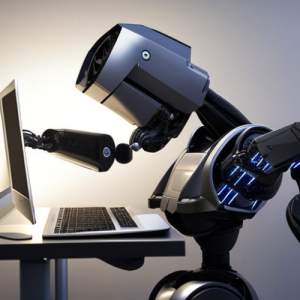The rise of new generative AI tools, particularly ChatGPT, has created a lot of buzz. Google and Microsoft announced major changes to their search engines. Economists are predicting shifts in the workforce. And closer to home, colleges and universities are debating how best to adapt.

We asked our own resident tech experts — the staff of ITS — for their thoughts on just one question: What changes are new AI tools like ChatGPT bringing to your area of IT?
From an accessibility expert:
“New technology has the potential to greatly enhance the digital experience for individuals with disabilities. We have seen this over the last few years with better [auto generated] captions, alt text and more. AI Tools like ChatGPT (if it was made accessible and 100% reliable) could be quick paths to information that currently takes a more exhaustive web search through a still largely inaccessible internet. However, I’m not sure the pros outweigh the cons as I feel these programs raise more issues such as plagiarism and loss of creativity.” – Chelsea Porter, Digital Accessibility Office
From an educational technologist:
“AI-driven ChatGPT has attracted considerable attention due to its ability to produce human-like text responses to a vast array of questions and prompts. At UNC, some instructors are already embracing the technology as a valuable productivity tool, using it to design grading rubrics, draft letters of recommendation, and explore its capabilities and limitations with students. However, there are also concerns about the potential for student plagiarism, intellectual property infringement, dissemination of misinformation, and the need for instructors to reimagine their course assignments and evaluation strategies.
As with all AI-driven tools, it’s still early days in terms of fully understanding the implications for teaching and learning. Nevertheless, it is clear that these tools will only become more sophisticated and powerful as time goes on. The Center for Faculty Excellence will soon resume its series of Conversations on Teaching and ChatGPT. Follow the CFE website for updates.” – Bob Henshaw, Educational Technologies and Center for Faculty Excellence (edited by ChatGPT)
From a software developer:
“As a software developer, I am relying more and more on ChatGPT for information and research. I am using it more frequently than my usual method of searching Google. Although the results from ChatGPT are often impressive, I have observed that there are instances when the information provided is incorrect. Despite this, I view ChatGPT as a turning point in technology and it’s exciting to see how it will continue to evolve.” – Brian Darley, Information Security Office
From a software engineer:
“As AI-based applications like ChatGPT and Stable Diffusion gather media attention and increase in use, the impact on our interactions with technology continues to rise. For the IT community, the ability for services like ChatGPT and GitHub Copilot to generate functional programming code based on prompt text briefly defining the need has immediate impact. Code that would previously take hours to conceive and write can now be generated in seconds.

In many cases, by following common patterns, this code may be better structured than something human created. Even if not perfect, the AI-generated code can often get a software developer much further in a short period of time compared to starting from scratch. To be used effectively, these tools must be balanced with existing skills in scrutiny and verification. At the same time, new skills such as the ability to generate prompts that yield the desired outcomes are already in demand.
Researchers at UNC-Chapel Hill are already working with groups like Research Computing to apply many of these same techniques and capabilities to today’s top problems. As use of these technologies increases so does the demand for computation resources, data storage and people with knowledge and expertise in how to apply them. There are often challenges when the ease of use of many of these consumer applications is expected in other areas where the software is less established.
There is tremendous opportunity in leveraging this type of technology; however, there is an equal, if not more important responsibility to understand the results. Recent advances in hardware capabilities through high performance GPUs and vast amounts of easily accessible training data have accelerated growth in this area.” – Rob Zelt, Research Computing
From a policy expert:
“One of the hardest things about writing policy (or anything) is getting started. In academic work, having help may be frowned on, but in professional life, unless you’re using someone else’s work without permission or citation, it’s smart to start with something that already exists. I think the biggest advantage of an AI like ChatGPT is getting a good starting point. Others might be:
- Efficiency: AI can quickly analyze and organize large amounts of information to create more efficient and effective policies.
- Accuracy: AI can check for and eliminate errors, inconsistencies and redundancies in the policy document.
- Consistency: AI can ensure that all policies are written in a consistent style and format, making them easier to understand and follow.
- Relevance: AI can ensure that policies are up-to-date and relevant to current technological trends and advancements.
- Customization: AI can easily generate customized policies that are tailored to specific organizations and their unique needs.
I’m excited about having help. Including this nice list of advantages my friend ChatGPT created for me.” – Kim Stahl, IT Policy Office (and ChatGPT, friendly helper)
From a platform architect:
“We enabled ServiceNow’s conversational AI (chatbot) in 2020, and there have been multiple improvements to AI in the platform in the last three upgrades. We’ve leveraged natural-language understanding (NLU) and built out conversations enabling campus customers to get what they need, when they need it. A couple of high performing conversations currently delivering self-service are ‘Password Reset,’ and ‘2-Step Verification’ and ‘Microsoft Office installation.’

To be successful, these conversations require monitoring and tweaking to ensure predictions (NLU) are presenting the correct topics to customers. Another key aspect of successful conversations is referencing them to up-to-date knowledge articles. Leveraging conversational AI provides always-on self-service, improving the customer experience, and freeing up Service Desk employees to focus on more meaningful work.
In the future, I would like to see in-platform AI and analytics gain interest as it would enable customers leveraging machine-learning (ML) algorithms with application logic for predicting auto assignment. It could also be enhanced using skills-based management, which enables managers to configure practical expertise skills and automating routine tasks to members matching those skills. This could also dovetail nicely into performance management.
AI tools are transformative for IT service management platforms and the full-service experience. AI-powered service management or AISM is an emerging approach which is positioned to solve challenges associated with ITSM. An obstacle with this emerging approach is that even with supervised machine-learning (ML), it’s only going to be as good as the data that is used to train it.” – David Smith, IT Service Management Platform
